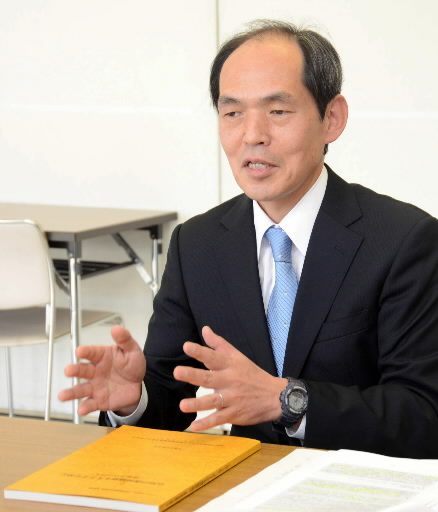Hiroshima city and prefecture release report on reconstruction of A-bombed city
Apr. 16, 2014
by Daigo Kanezashi, Staff Writer
On April 9, Hiroshima Prefecture and the City of Hiroshima released a report which details the steps Hiroshima has taken to reconstruct the city since the devastation wrought by the atomic bombing. The report emphasizes not only urban development, but also other aspects that have affected the lives of citizens, like media reporting and the medical environment. Fifteen experts in each field analyzed these areas from a variety of perspectives in producing the report. The prefecture and city hope that the report will aid others in reconstructing disaster-hit areas, including the region affected by the Great East Japan Earthquake and nations suffering strife, by providing information that can help build peaceful cities.
The report, titled (tentatively) “Revival from Devastation: Making Use of Hiroshima’s Experience of Reconstruction,” was compiled by an executive committee, formed by Hiroshima Prefecture and the City of Hiroshima, over fiscal years 2012 and 2013. Experts involved in writing the report included staff from Hiroshima University and Hiroshima Peace Memorial Museum. The A4-sized document consists of 164 pages. To date, 800 copies have been printed.
The report features milestones in urban redevelopment, including the municipal Motomachi Apartments, located in Naka Ward. While the city succeeded in strengthening its infrastructure, it also faced the downside of reconstruction, such as issues involving forced evictions and illegal construction. The report says that the road to reconstruction does not run straight, that conflicts and disputes will sometimes occur, but by overcoming these difficulties, reconstruction can firmly take root.
Although other literature in the field focuses similarly on the reconstruction of city functions, the report is also characterized by its attempt to shed light on the lives of citizens. It describes media coverage of the A-bomb catastrophe, the black markets that appeared after the war, and the efforts at reviving daily life made by citizens, such as open-air classes in lieu of functional school buildings. The report indicates that even during days of hardship, children attended schools that had reopened and dreamed of the future. It also recounts the development of medical treatment for A-bomb survivors, saying that, from this, a contribution to the medical treatment for those exposed to radiation around the world has been made.
The prefecture and city will distribute the report to public libraries and universities located in Hiroshima Prefecture. The English version and a digest version of the report will be made available on official websites by the end of this fiscal year. Kazumi Mizumoto, the vice president of the Hiroshima Peace Institute at Hiroshima City University, who served as chief of the editorial board, commented, “No matter the destruction, reconstruction is always possible. I hope that this report will help transmit to the world the example of Hiroshima, which has overcome pain and sorrow to build a peaceful city.”
(Originally published on April 10, 2014)
On April 9, Hiroshima Prefecture and the City of Hiroshima released a report which details the steps Hiroshima has taken to reconstruct the city since the devastation wrought by the atomic bombing. The report emphasizes not only urban development, but also other aspects that have affected the lives of citizens, like media reporting and the medical environment. Fifteen experts in each field analyzed these areas from a variety of perspectives in producing the report. The prefecture and city hope that the report will aid others in reconstructing disaster-hit areas, including the region affected by the Great East Japan Earthquake and nations suffering strife, by providing information that can help build peaceful cities.
The report, titled (tentatively) “Revival from Devastation: Making Use of Hiroshima’s Experience of Reconstruction,” was compiled by an executive committee, formed by Hiroshima Prefecture and the City of Hiroshima, over fiscal years 2012 and 2013. Experts involved in writing the report included staff from Hiroshima University and Hiroshima Peace Memorial Museum. The A4-sized document consists of 164 pages. To date, 800 copies have been printed.
The report features milestones in urban redevelopment, including the municipal Motomachi Apartments, located in Naka Ward. While the city succeeded in strengthening its infrastructure, it also faced the downside of reconstruction, such as issues involving forced evictions and illegal construction. The report says that the road to reconstruction does not run straight, that conflicts and disputes will sometimes occur, but by overcoming these difficulties, reconstruction can firmly take root.
Although other literature in the field focuses similarly on the reconstruction of city functions, the report is also characterized by its attempt to shed light on the lives of citizens. It describes media coverage of the A-bomb catastrophe, the black markets that appeared after the war, and the efforts at reviving daily life made by citizens, such as open-air classes in lieu of functional school buildings. The report indicates that even during days of hardship, children attended schools that had reopened and dreamed of the future. It also recounts the development of medical treatment for A-bomb survivors, saying that, from this, a contribution to the medical treatment for those exposed to radiation around the world has been made.
The prefecture and city will distribute the report to public libraries and universities located in Hiroshima Prefecture. The English version and a digest version of the report will be made available on official websites by the end of this fiscal year. Kazumi Mizumoto, the vice president of the Hiroshima Peace Institute at Hiroshima City University, who served as chief of the editorial board, commented, “No matter the destruction, reconstruction is always possible. I hope that this report will help transmit to the world the example of Hiroshima, which has overcome pain and sorrow to build a peaceful city.”
(Originally published on April 10, 2014)








